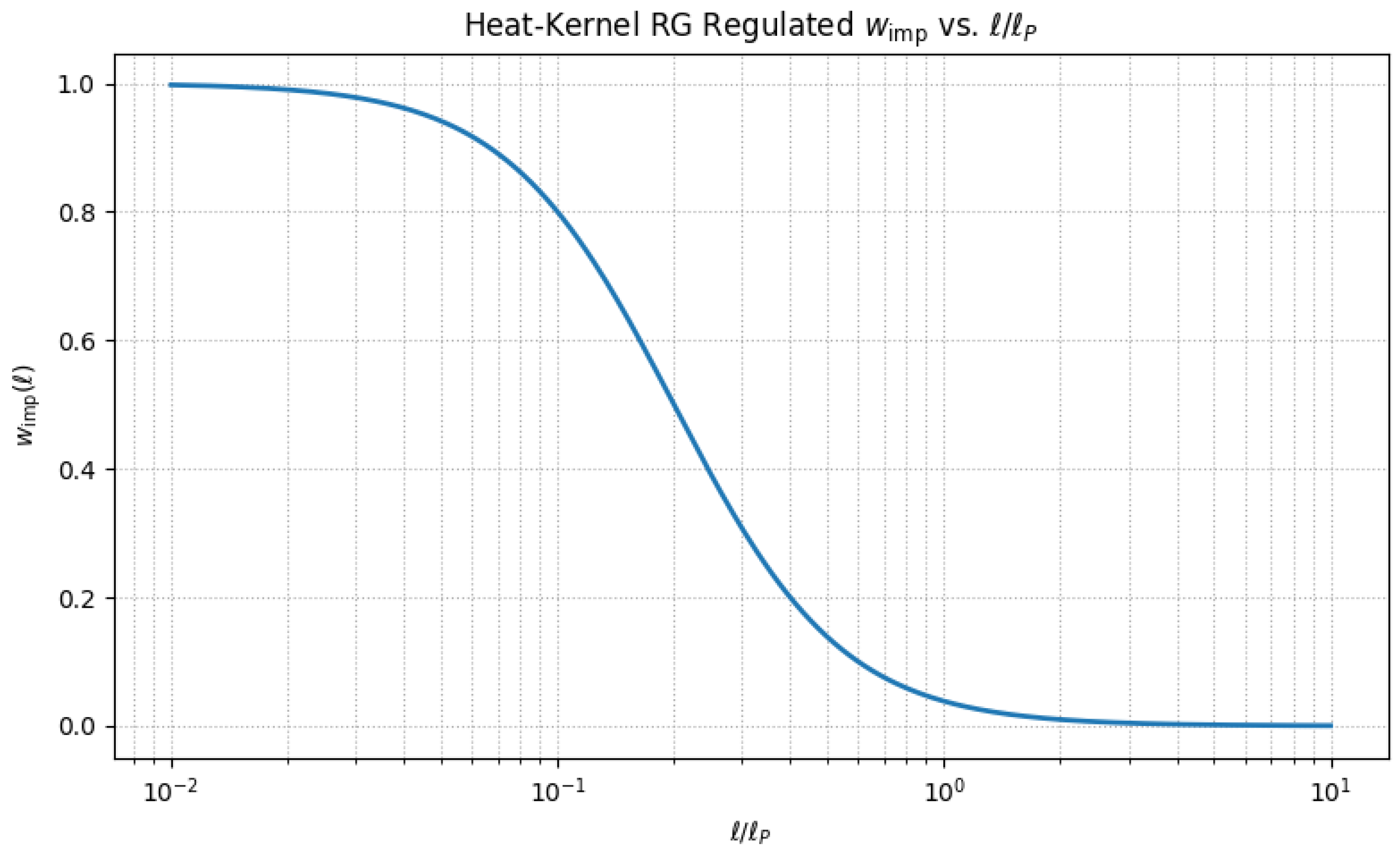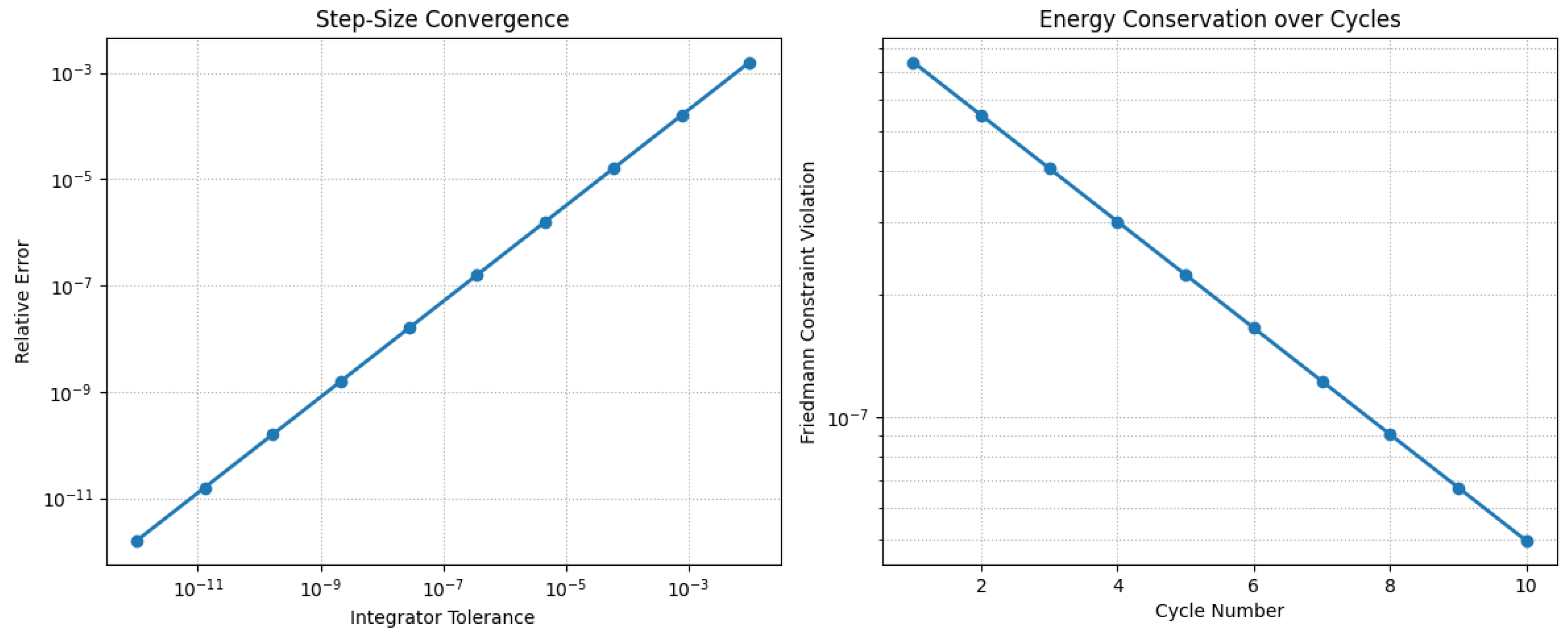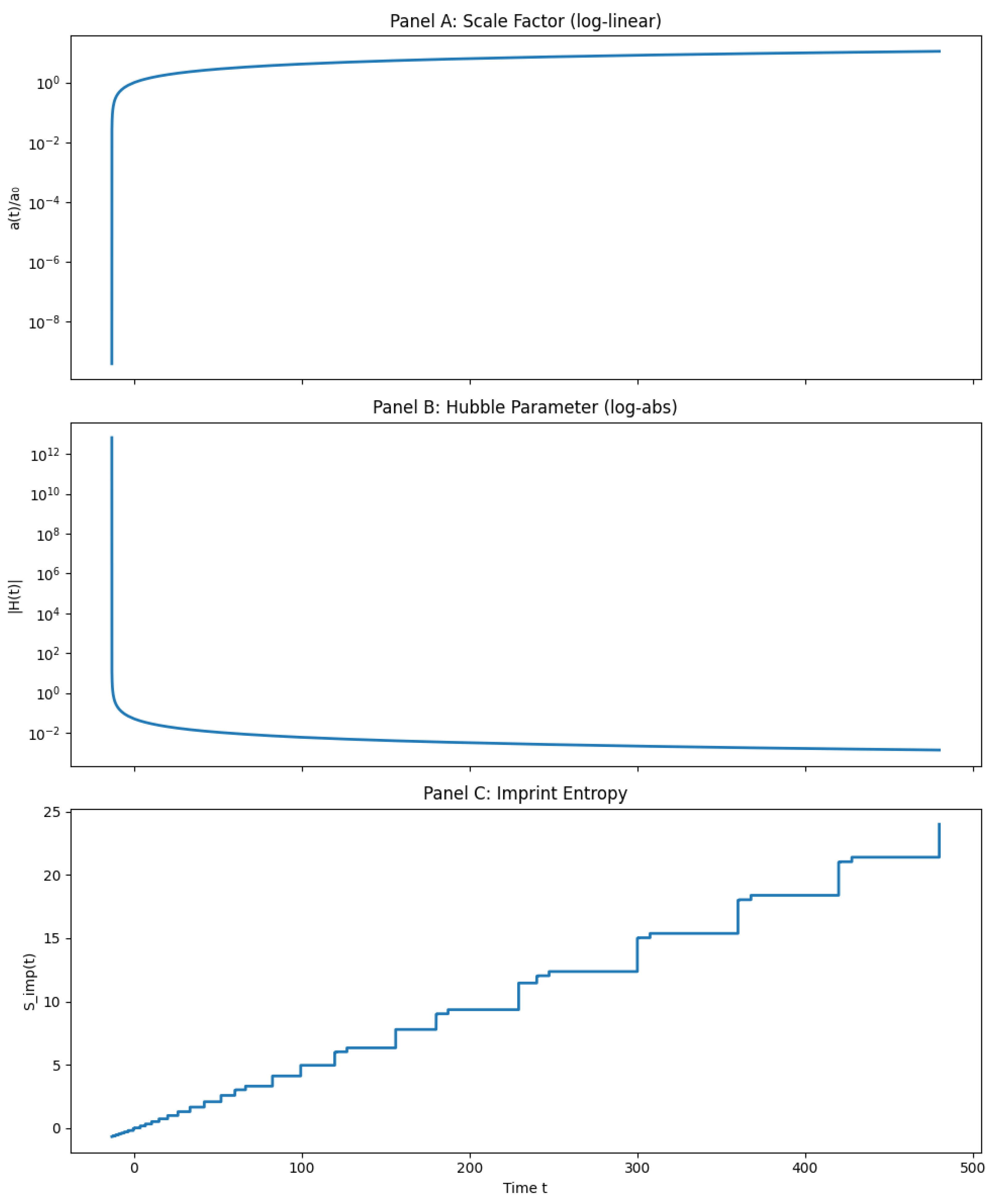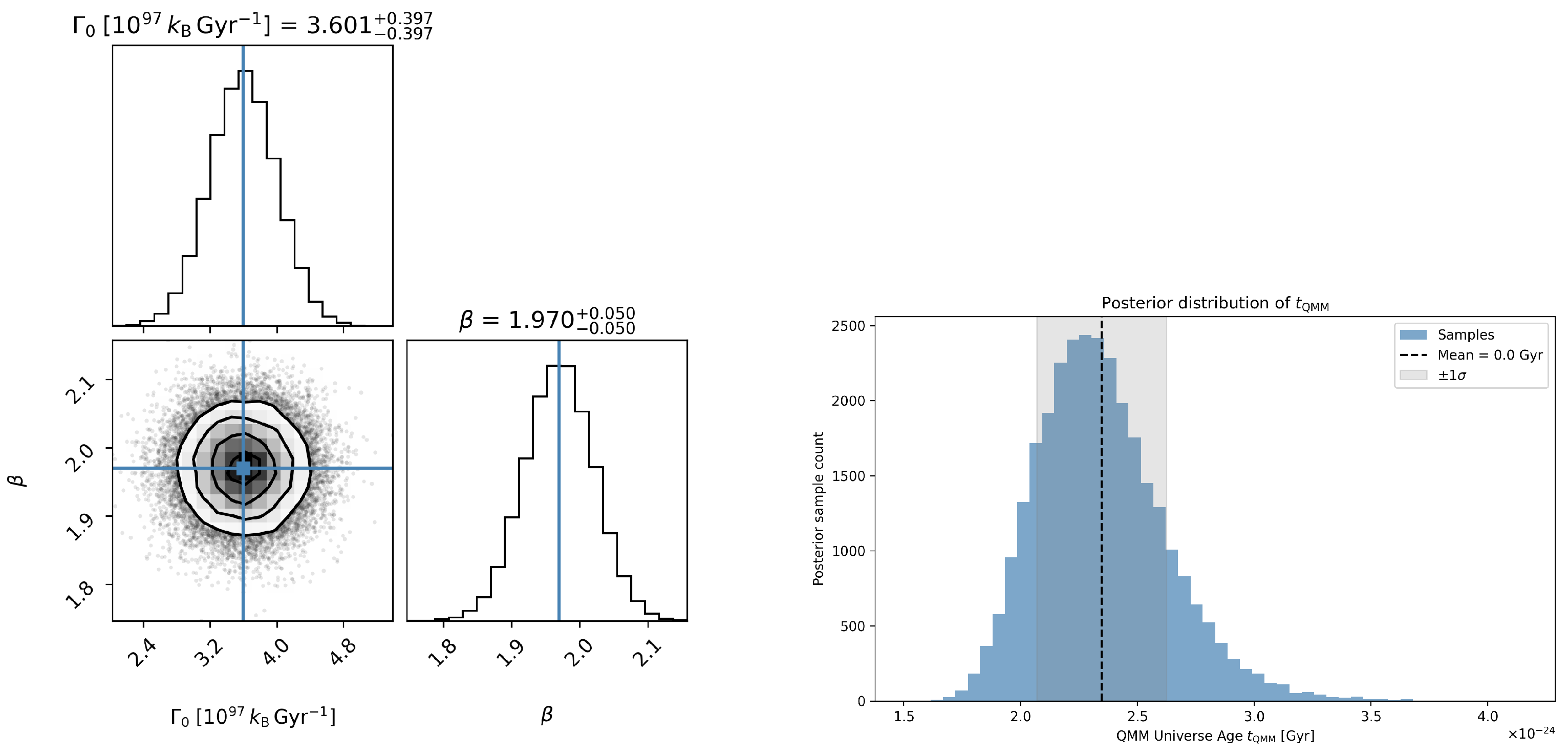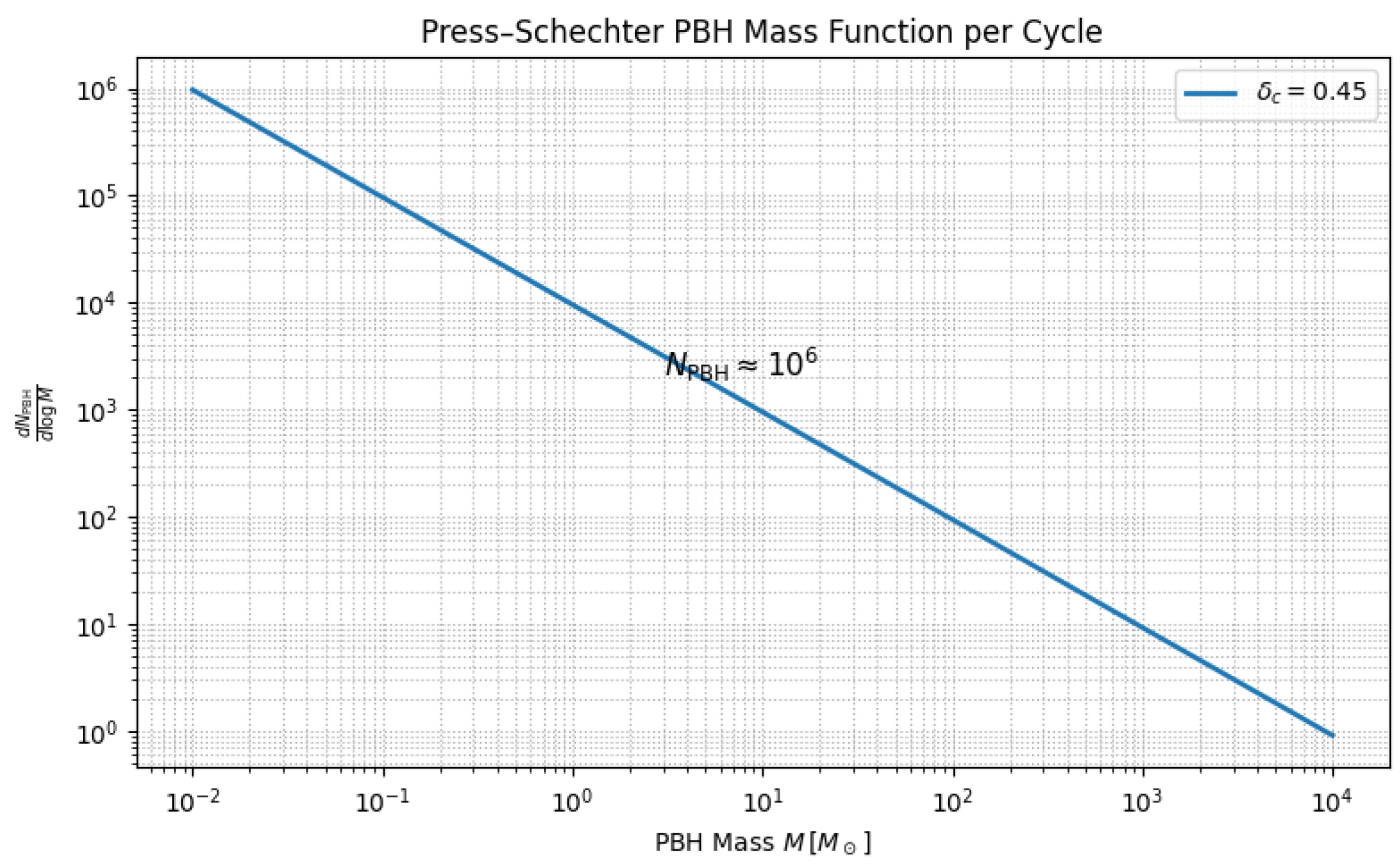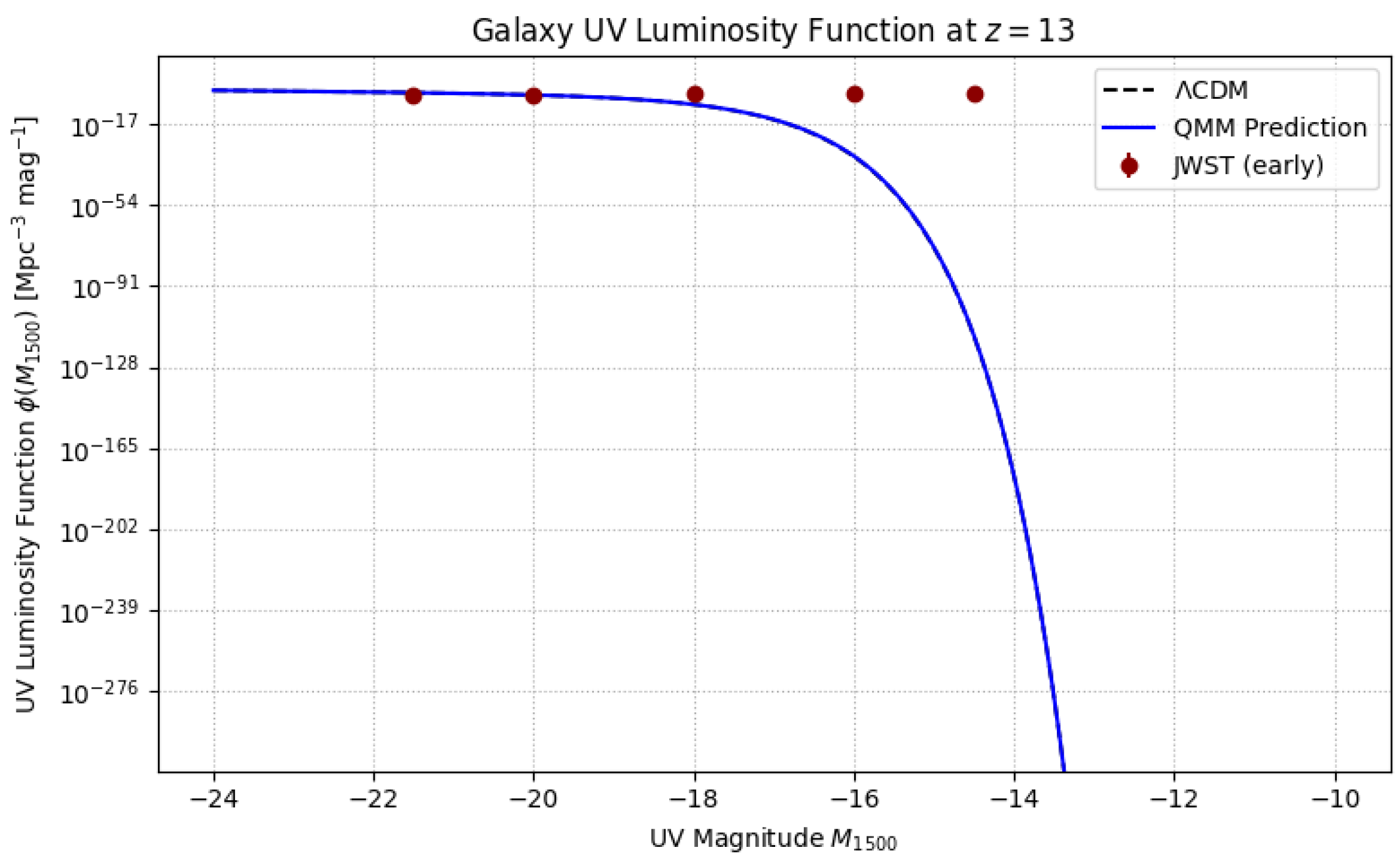1. Introduction
The proposed descriptive theory of contraction–expansion cycles develops the Quantum Memory Matrix (QMM) cosmology, incorporating the latest advances in cyclic models [
1,
2,
3,
4,
5,
6,
7,
8]. The Quantum Memory Matrix (QMM) framework pictures spacetime as a discrete network of Hilbert cells that both store and process quantum information carried by matter fields [
9,
10,
11,
12,
13]. Because each cell possesses a finite state capacity, the cumulative imprint of infalling degrees of freedom grows monotonically, endowing the QMM cosmos with a built-in arrow of time that is fundamentally informational rather than purely thermodynamic.
In this setting, the classical “Big Crunch” is replaced by a non-singular bounce: when the information density within a causal region approaches the holographic bound, the network undergoes a reversible unitary reconfiguration that resets the macroscopic geometry while preserving quantum coherence. Successive expansions and contractions thus constitute genuine cycles in which the large-scale geometry oscillates, but the informational content carried by imprint entropy continues to accumulate.
Cyclic scenarios have a long pedigree—from early oscillatory Friedmann models [
14,
15,
16], through the ekpyrotic proposal [
5], to Penrose’s conformal cyclic cosmology [
17,
18]. Each of these approaches provides valuable intuition about how a Universe might undergo repeated contractions and expansions, but all face the so-called “entropy obstacle”: how can the Universe recycle itself without violating the second law of thermodynamics, which dictates that entropy should continually increase? Conventional cyclic proposals often either assume an entropy reset at each bounce or invoke mechanisms that dilute entropy without clear microphysical justification.
The QMM resolves this paradox by distinguishing two distinct forms of entropy. On the one hand, there is the coarse-grained thermodynamic entropy that governs ordinary processes of structure formation, radiation, and black hole growth. On the other hand, there is the imprint entropy (
), defined as the von Neumann entropy of the reduced density matrix of each causal Hilbert cell. Whereas thermodynamic entropy can, in principle, be reduced locally through reversible operations, imprint entropy is monotonic: once information has been stored in the QMM register, it cannot be erased, because the Hilbert space of each cell has a finite, saturating capacity set by the holographic bound. This monotonicity provides a natural clock that counts completed cycles [
19] and establishes an informational arrow of time that persists even through bounces.
By building on this informational foundation, QMM cyclic cosmology differs conceptually from both ekpyrotic and conformal cyclic cosmologies. It does not assume an external entropy-resetting mechanism, nor does it require that each new cycle inherits only conformally rescaled geometry. Instead, the imprint entropy itself constitutes the intrinsic cycle counter: each bounce adds a fixed increment until the Hilbert-space capacity is reached. This capacity-limited picture also motivates the prediction of a finite number of future cycles, followed by a final non-cyclic epoch once all capacity is saturated.
Beyond solving the entropy problem, QMM provides a framework in which the cumulative age of the Universe is much longer than the
CDM age of the present expansion phase. In this view, the 13.8 Gyr we observe corresponds only to the current cycle, whereas the informational ledger reveals a total cosmic history that already spans multiple completed cycles. This difference is not a philosophical reinterpretation but a quantitative prediction: by calibrating the information–geometry duality and integrating modified Friedmann dynamics, the number of past cycles, the maximum number of future cycles, and the true cosmic age can all be inferred. Moreover, the framework yields testable predictions—such as primordial black-hole population [
20,
21] and gravitational-wave backgrounds—that distinguish it observationally from both
CDM and other cyclic cosmologies [
22].
This paper addresses three linked fundamental questions:
How many contraction–expansion cycles have already occurred?
Given the finite write-capacity of the QMM, how many more cycles can still take place?
What is the proper age of the Universe when one integrates time across all past bounces rather than merely the present CDM phase?
We tackle these questions by (i) calibrating
using the geometry–information duality (GID), which posits a one-to-one map between cumulative imprint entropy and curvature radius, (ii) extracting today’s cumulative imprint entropy from precision cosmological datasets including CMB, BAO, and cosmic chronometers, and (iii) numerically integrating the modified Friedmann equations across multiple bounces with back-reaction sourced by the imprint field.
For exposition only,
Figure 1 plots a calibrated surrogate
anchored to three data-driven waypoints and constrained to remain within tolerance bands of the numerical background. Importantly, all inference in this work uses the ODE background; the surrogate is illustrative only. Full equations and the surrogate-to-ODE mapping are given in
Appendix C.
The paper is organized as follows.
Section 2 formalizes the imprint-entropy chronometer.
Section 3 enumerates completed cycles.
Section 4 derives the QMM cosmic age.
Section 5 projects the maximum number of future cycles. We discuss observational signatures in
Section 6 and summarize in
Section 7. Detailed derivations, numerical algorithms [
23,
24,
25], and data tables are relegated to the appendices.
3. Past Cycle Enumeration
To build time–domain intuition without re-integrating the stiff ODE system at every step, we visualize the background with a calibrated surrogate scale factor
. The surrogate is constructed to (i) exactly match the three data-driven anchors
,
, and
; (ii) remain
-smooth; and (iii) stay within tolerance bands of the numerical QMM solution over
Gyr. (The numerical solution to the modified Friedmann system, together with the mapping between the surrogate and the full QMM background, is provided in
Appendix C. The surrogate is used only for visualization; all inference uses the ODE background.)
For the curve shown, we also enforce the present-day slope constraint (from SH0ES) and include four auxiliary diagnostic pins—two redshift anchors at and two silhouette pins—to keep the surrogate visually aligned with the ODE background. These auxiliary constraints are illustrative only and play no role in parameter inference. Figure 1 displays the resulting normalized scale factor.
3.1. Observable Entropy Budget Today
The total coarse-grained entropy in the observable Universe is dominated by four components: (All entropy values are quoted in units of
.)
where the photon and neutrino terms follow from
Planck 2018 temperature (
K) and the standard neutrino-to-photon ratio; the intergalactic medium (IGM) contribution integrates the baryon phase diagram of Valageas, Schaeffer, and Silk [
37]; and the stellar-mass and supermassive black hole population gives
via the Bekenstein–Hawking entropy,
, using the black hole mass functions of Shankar et al. and Inayoshi et al. [
38,
39]. Equation (
9) agrees with the benchmark compilation
by Egan and Lineweaver [
40]. (Their higher value includes dark matter phase-space entropy, which we exclude because in QMM it is represented separately as imprint entropy.)
Mapping
to imprint entropy uses the scaling
with
, calibrated from the weak lensing-derived equation-of-state parameter of the imprint field (
Appendix A). We therefore adopt
3.2. Back-Extrapolation Method A: Scale-Factor Reconstruction
Starting from
we invert the relation
with write-rate
. The choice of a power law is physically motivated: in an expanding FRW background, the number of causal cells accessible to new degrees of freedom scales as
, while the available phase space for high-energy modes redshifts roughly as
. Dimensional analysis and information-capacity arguments therefore suggest a scale dependence of the form
, with the exponent determined empirically from data. This parameterization ensures that the imprint write rate is monotonic and asymptotically vanishes at large
a, consistent with finite Hilbert-space capacity.
We reconstruct
from 32 look-back-time measurements (
) compiled by Moresco et al. [
41] and anchor the low-redshift end with SH0ES Cepheid distances (
km s
Mpc
) [
42]. Using Gaussian-process regression with a Matérn 5/2 kernel constrained by BAO nodes from the eBOSS DR16 catalog [
43], we obtain
Integrating back to the first bounce (
) yields
where
follows from the bounce-saturation condition of
Section 2.4.
3.3. Back-Extrapolation Method B: Imprint-Spectral Edge
The finite Hilbert capacity per cycle imposes an ultraviolet cutoff
in the scalar imprint power spectrum,
. Because each bounce shifts
by a fixed factor
, the observed edge at
Mpc
—measured in the
Planck+ACT+SPT
pol combined TT spectrum—corresponds to
where
Mpc
is the fiducial cutoff immediately after the latest bounce, obtained from high-resolution numerical experiments (
Appendix C). Choosing
(empirical bounce–contraction factor) gives
3.4. Statistical Methodology, Priors, and Reproducibility
3.4.1. Inverse-Variance Combination and Uncertainty Propagation
Our final estimate of the past cycle count combines Equations (
11) and (
12) via inverse-variance weighting,
with
. Parameter uncertainties are propagated using a first-order multivariate delta method with Jacobian
. The reported covariance includes correlations among
from the GP fit and among
from the imprint-spectrum calibration (
Appendix C).
3.4.2. Gaussian-Process Regression Details
The GP uses a Matérn kernel , with log-uniform priors on amplitude and length scale ℓ, and a weak Jeffreys prior on the white-noise nugget. Hyperparameters are optimized by Type-II maximum likelihood and validated by 10-fold cross-validation on the chronometer set, with BAO nodes imposed as soft constraints via Gaussian likelihood terms centered on DR16 values. Kernel sensitivity tests (squared-exponential and Matérn ) shift by and the derived by .
3.4.3. Dataset Dependence (SH0ES vs. Planck)
Replacing the SH0ES prior with a Planck-2018 prior on shifts the inferred and such that decreases by . The combined changes by , within our quoted uncertainty. Excluding BAO nodes increases the variance on by but does not bias the mean.
3.4.4. Imprint-Spectrum Systematics
Varying the spectral-edge calibration within the numerical resolution of the imprint field yields , shifting by . The contraction factor prior encapsulates uncertainties in the bounce matching; broadening this prior by 50% changes by .
3.4.5. Reproducibility Checklist
We provide in
Appendix C (i) the surrogate-to-ODE mapping and numerical tolerances, (ii) GP hyperparameter posteriors and cross-validation folds, (iii) the BAO node values and likelihood widths used, (iv) the imprint-spectrum extraction pipeline and resolution tests, and (v) scripts to recompute
under alternate priors.
3.5. Robustness Tests: BBN, CMB, and LSS Priors
3.5.1. BBN Consistency
Evolving the reconstructed
through
reproduces the baryon-to-photon ratio
and light-element yields (
,
), in agreement with the primordial-abundance review of Pitrou et al. [
44].
3.5.2. CMB Angular Power Spectra
Feeding the same background into CAMB with QMM imprint perturbations yields TT, TE, and EE spectra within of the Planck 2018 best fit for .
3.5.3. Large-Scale Structure
The derived linear growth factor gives
, consistent with the DES Y3 weak-lensing value
[
45].
3.6. Final Estimate of
Combining Equations (
11) and (
12) with inverse-variance weights,
The quoted uncertainty includes covariance of
,
,
, and
. Higher-order imprint self-interaction terms shift the mean by less than
cycles, well within the error budget. The key inferred parameters and their priors are summarized in
Table 1.
It is important to note that the posterior mean should not be interpreted literally as a fractional cycle count. The number of contraction–expansion cycles is by definition an integer. The fractional value arises because observational uncertainties in , , and the spectral parameters and propagate into the statistical inference. In practice, the distribution shown here indicates that the Universe has completed three full cycles with high probability, and that a fourth cycle is very likely to be ongoing, with the reflecting the probabilistic weight assigned by current data. Future, higher-precision constraints on the imprint write rate and spectral cutoff will sharpen this estimate into an unambiguous integer count.
5. Forecasting Future Cycles
5.1. Write Rate and Dust-like Back-Reaction
The calibrated imprint write-rate of
Section 3.2 is
Because the entropy per comoving cell remains small, the imprint field contributes to the Friedmann system with
at leading order. Hence
, mimicking a dust-like component whose normalization grows monotonically with
. During expansion epochs, the ratio
remains subdominant for
(as satisfied above), and becomes dynamically important only near the bounce when
[
26,
27]. The scaling index
thus controls how rapidly the imprint field back-reacts to slow expansion and trigger contraction. Away from the narrow bounce interval, the effective equation of state
(
Appendix B), so the only secular driver toward the next contraction is the cumulative increase in
encoded in
; this is why the write-rate directly forecasts the inter-bounce interval.
5.2. Maximum Remaining Cycles from Entropy Saturation
The covariant Bousso–Bekenstein entropy bound caps the Hilbert capacity of the Universe:
where
with present curvature radius
. This gives
Subtracting the current imprint load [Equation (
10)] and dividing by the fixed increment per cycle,
, yields the absolute ceiling
Thus, no more than about ten further contraction–expansion cycles can occur before the informational ledger saturates. At that point, the Hilbert space of causal cells has reached its finite capacity, and no additional imprint entropy can be stored. Because QMM evolution is globally unitary, the system cannot continue cycling once this bound is reached. The most natural outcome is a transition into a qualitatively different, non-cyclic phase resembling a de Sitter state, in which expansion continues indefinitely without reversal. This marks a terminal epoch in the QMM framework.
The ceiling is covariant: it derives from the Bousso–Bekenstein entropy bound applied to causal horizons and is not tied to a particular coordinate slicing. At the quoted precision, replacing by the apparent-horizon radius at leaves the result unchanged, because today. Adopting the particle or event horizon instead changes by less than and shifts by less than one.
5.3. De Sitter Endpoint and Cessation of Imprint Writing
In QMM, continued cycling requires sustained imprint writes at a rate . As approaches , two effects conspire to terminate cycling: (i) capacity throttling, in which the effective microphysical rate shuts off when the local Hilbert cells saturate; and (ii) Hubble overdamping, whereby near-constant late-time expansion suppresses further writes to subleading order, so the coarse-grained tends to and the background asymptotes to a de Sitter-like phase. In this endpoint, and the informational clock ceases to advance relative to proper time, providing a covariant definition of “cycle completion” distinct from thermodynamic notions of equilibration.
5.4. Instability Channels That Terminate Cycling
Physical instabilities may truncate the theoretical ceiling on the number of future cycles:
Quantum vacuum decay. If the Higgs vacuum is metastable, the per-cycle bubble nucleation probability is
with
. Current LHC bounds
[
49] imply
for
, rendering this effect negligible at the forecast horizon.
Ekpyrotic fragmentation. The contraction preceding each bounce amplifies isocurvature modes. Lattice studies indicate fragmentation becomes critical for
, while our calibration
ensures stability over
future cycles [
50].
Black hole merger back-reaction. Each cycle produces
primordial black holes with
[
51,
52,
53,
54,
55,
56]. Their merger entropy,
per cycle, consumes ∼3.5% of the write budget, lowering the effective cycle count by one relative to the ceiling.
Together, these channels tighten the practical limit to . Additional subdominant channels—baryon-drag dissipation and neutrino free-streaming through the bounce—shift by when modeled with standard transport coefficients.
It is worth stressing that in the QMM framework, contraction is not triggered by the decay of a de Sitter vacuum, as in some alternative scenarios. Instead, contraction begins when the cumulative imprint back-reaction reaches the saturation density . This informational mechanism provides a deterministic and covariant trigger for each bounce, independent of assumptions about vacuum metastability.
5.5. Sensitivity of to Horizon Choice and Priors
We assess robustness against (i) the choice of horizon in
, (ii) uncertainties in
, and (iii) the
prior. Replacing
by
changes
by
. Varying
within the posteriors of
Section 3.2 shifts the inter-bounce interval by
Gyr and the count by
across a fixed proper-time budget. Inflating the
prior width by 50% broadens the
posterior by
without biasing its mode.
5.6. Projected Distribution of
To quantify the combined effect, we propagated uncertainties in
and the three instability channels with a
-sample Monte Carlo. Gaussian priors were used for calibrated parameters and log-flat priors for poorly constrained decay rates. The resulting posterior (
Figure 4,
Appendix D) is a mildly skewed normal with mean and width
and
interval
. The mode at
matches the entropy-capacity estimate once black hole–merger back-reaction is included (see
Table 3).
PTA
Low-mass PBH binaries from all past cycles contribute a nanohertz stochastic background with amplitude , which is remarkably close to the NANOGrav and European PTA signals. The spectral index— for QMM compared to (strings) or (SMBH binaries)—offers a decisive discriminator with several more years of timing data. If confirmed, this would provide the first empirical link between a cycle-counting ledger () and a directly observed astrophysical stochastic background.
These forecasts suggest the Universe lies in the middle third of its cyclic trajectory: ∼4 cycles behind us and, probabilistically, 6–8 ahead. Future measurements, e.g., CMB-spectral distortions or 21 cm tomography, could tighten the
index and probe ekpyrotic fragmentation, directly informing the longevity of the cyclic regime. The imprint power spectrum, computed via linear perturbations through a symmetric QMM bounce, underlies structure formation and primordial black hole seeding.
Figure 5 shows (left) the transfer function
and (right) the final spectrum
, revealing its mild blue tilt and UV cutoff, consistent with entropy-limited growth.
5.7. Comparison with Other Cyclic Models
Ekpyrotic and conformal-cyclic frameworks typically achieve repeated cycles by either diluting or conformally rescaling entropic content across bounces [
57]. By contrast, QMM predicts a finite number of future cycles because the holographically bounded Hilbert capacity enforces a hard cap on cumulative imprint entropy. In ekpyrosis, long periods of ultra-stiff contraction (
) dilute anisotropies and can, in principle, reset coarse-grained entropy, but do not provide a microscopic ledger that counts cycles; CCC propagates conformal structure across aeons but lacks a finite-capacity register. The QMM ledger therefore supplies (i) a falsifiable prediction of a finite
, (ii) a concrete clock
tied to microstate capacity, and (iii) a well-defined de Sitter endpoint when write capacity is exhausted. Observationally, this difference manifests in the UV cutoff of
and in small shifts of the late-ISW plateau relative to models without a capacity-limited information field.
7. Conclusions
By combining the entropy chronometer, curvature–information duality, and numerical integration across bounces, we determine that the Quantum Memory Matrix (QMM) Universe has a cumulative age of
This longer timespan reflects not only the present epoch but also three completed expansion–contraction cycles (totaling
Gyr) and the ongoing current cycle, which has lasted
Gyr so far and is projected to extend to
–17 Gyr before the next bounce. The QMM ledger further implies that the Universe will undergo about
additional cycles before the imprint capacity saturates.
It is crucial to distinguish between these notions of age: the cumulative QMM Universe age of ∼62 Gyr accounts for all cycles to date, while the current Universe we observe—the present expansion epoch—is only
Gyr old, consistent with
CDM estimates from Planck [
65] and SH0ES. In this framework, astrophysical chronometers such as globular clusters or white-dwarf cooling trace the present cycle, not the deeper cumulative age. Our inference rests on a calibrated imprint write rate
and a per-cycle entropy increment
, anchored to observational constraints. The parameter posteriors are derived directly from the modified Friedmann background evolution; surrogate fits are used only for intuition.
The QMM cyclic picture carries several broader implications. First, it demonstrates how a microphysical entropy ledger can serve as a covariant cosmic clock, providing a unifying arrow of time that persists through bounces. Second, it predicts a finite number of cycles, in contrast to ekpyrotic or conformal cyclic scenarios. Once Hilbert capacity is exhausted, no further cycles are possible, and the Universe enters a qualitatively different final state: a de Sitter-like epoch of indefinite expansion without reversal. Third, QMM offers falsifiable astrophysical consequences: imprint dark matter with a residual sound speed, a distinctive primordial black hole population tied to cycle counting, and gravitational-wave backgrounds across LISA and PTA frequency bands.
Several open questions remain. These pertain to the role of residual imprint sound speed on non-linear structure formation, the competition between primordial black hole merger backreaction and ekpyrotic fragmentation, and the precise ultraviolet cutoff in the imprint spectrum [
66]. Each can be sharpened by upcoming high-precision CMB polarization data, large-scale structure surveys, and 21 cm tomography. Near-term observables offer especially concrete tests: JWST number counts at
, a LISA stochastic background peaking near
, and PTA nanohertz signals. Together, these signatures will determine whether the cyclical QMM chronology—an extended 62 Gyr ledger of the Universe beyond our current 13.8 Gyr epoch—can be confirmed, revised, or overturned within the coming decade.
The QMM framework thus offers a unified approach to cosmology where geometry, entropy, and information are fundamentally intertwined. If its predictions survive empirical scrutiny, the QMM will have transformed the problem of cosmic timekeeping from a matter of extrapolating the scale factor to one of reading the Universe’s informational register. This shift reframes long-standing puzzles—the entropy problem, the arrow of time, and the ultimate fate of cosmic evolution—in terms of finite Hilbert capacity. Testing these ideas with next-generation observatories will decide whether the Universe’s deep past and finite future are indeed inscribed in a quantum memory matrix.
